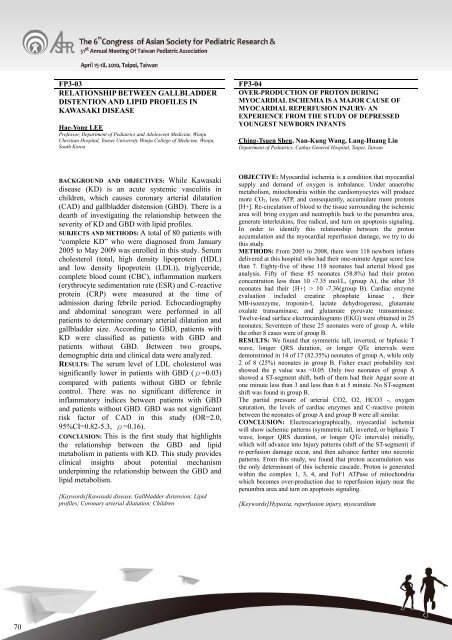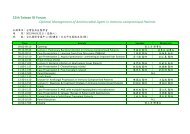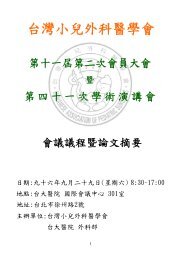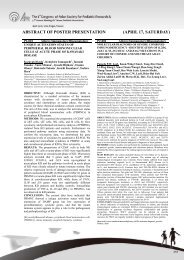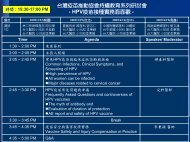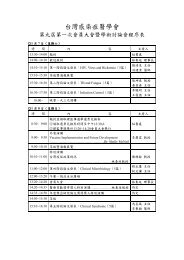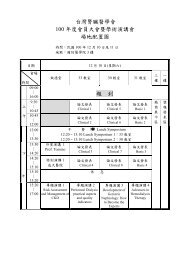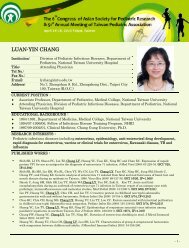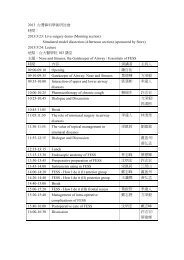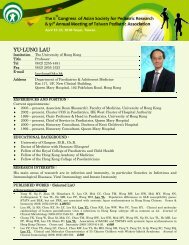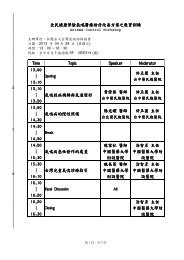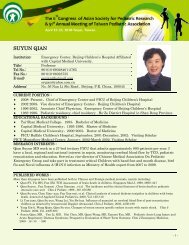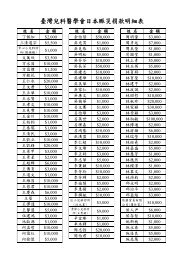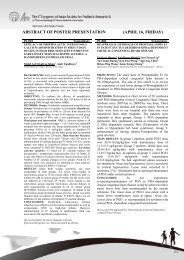FP3-01AN ASSOCIATION BETWEEN ITPKC GENEPOLYMORPHISMS <strong>AND</strong> CORONARYARTERIAL LESIONS IN KAWASAKIDISEASE: FROM THEIR DEVELOPMENT<strong>AND</strong> SEVERITY TO REGRESSIONMing-Tai Lin 1 , Jou-Kou Wang 2 , Li-Chuan Sun 3 ,Jia-Feng Wu 4 , Chun-An Chen 5 , Shuenn-Nan Chiu 6 ,Mei-Hwan Wu 7Department of Pediatrics, National Taiwan University Hospita, Taiwanl 1 ;Pediatric, National Taiwan Hospital, Taiwan 2 ; Pediatrics, Cardinal TienGeneral Hospital, Taipei, Taiwan 3 ; Pediatrics, National Taiwan UniversityHospital,Taiwan 4 ; Department of Pediatrics, National Taiwan UniversityHospital, Taiwan 5 ; Pediatrics, National Taiwan University Hospital 6 ,Pediatric Cardiology, National Taiwan University Hospital, Taiwan 7FP3-02DIFFERENT GENETIC ASSOCIATION <strong>AND</strong>GENE-GENE INTERACTION ON THESUSCEPTIBILITY <strong>AND</strong> CORONARY ARTERYLESIONS <strong>OF</strong> KAWASAKI DISEASEHo-Chang Kuo, MD, a, d Chi-Di Liang, MD, b Chih-Lu Wang, MD,PhD, f Hong-Ren Yu, MD, a, d I-Chun Lin, MD, b, d Chieh-An Liu,MD, a Jen-Chieh Chang, MS, e, g Chiu-Ping Lee, MS, e Lin Wang,MD, a, d Kao-Pin Hwang, MD, PhD, c Kuender D. Yang, MD, PhD a, dDivision of Allergy, Immunology and Rheumatology, a Division of Cardiology, b andDivision of Infectious disease; c Department of Pediatrics, Chang Gung MemorialHospital-Kaohsiung Medical Center, Taiwan. Graduate Institute of ClinicalMedical Science, Chang Gung University, Kaohsiung, Taiwan. d Genomic CoreLaboratory, Chang Gung Memorial Hospital Kaohsiung Medical Center, Taiwan. ePo-Jen Hospital, Kaohsiung, Taiwan. f Institute of Biomedical Sciences, NationalSun Yat-Sen University, Kaohsiung, Taiwan. gThe IVS1+9 G/C ITPKC polymorphism (rs28493229) has been linked to susceptibility toKawasaki disease (KD). This study examines theinfluence of this polymorphism on subsequentcoronary arterial lesions (CAL) from theirdevelopment and severity to regression. Acase-control study was conducted among 280 KDpatients with 1,127 person-years follow-up (118without any CAL from KD onset and 162 with CAL;medium/giant coronary aneurysms in 51 and small in111) and 492 healthy ethnically- and gender-matchedcontrols. Regression of CAL was defined asnormalized CAL by echocardiography withcomputed tomography conformation. We found thatthe ITPKC IVS1+9 GC and CC genotypes and the Callele frequency were higher in KD patients than incontrols (p=0.001). Among KD patients, however,the GC and CC genotypes (χ 2 = 0.23, p= 0.63) andthe C allele (χ 2 = 0.41, p= 0.52) were notover-represented among patients with CALcompared to those without. In those with CAL, the Callele of ITPKC IVS1+9 was not related to theseverity of CAL and was not associated with itsregression. We conclude that although the ITPKCIVS1+9 G/C polymorphism is a risk factor for KD,it’s not a risk for the development of CAL and itslong-term outcome.[Keywords]Kawasaki Disease, ITPKC Gene, Coronary ArterialLesions, Regression, PolymorphismBACKGROUND: Kawasaki disease (KD) is a systemic vasculitis ofunknown etiology, and primarily affects children less than 5 years ofage. Previous genetic studies identified certain candidate gene(s) for thesusceptibility and coronary artery lesion (CAL) of KD, but not able tobe validated in other studies. We have recently found that an augmentedinnate immunity with dysregulated adaptive immunity was involved inthe susceptibility of KD, and a skewed Th1/Th2 immune response wasfound in CAL of KD. We therefore hypothesize that different immunegenes are responsible for the susceptibility and CAL complication ofKD, respectively. This study was conducted to investigate whetherdifferent genetic association and gene-gene interactions on thesusceptibility and CAL of KD.METHODS: A total of 801 case (226 KD patients and 575 controls)DNA samples were subjected to a multiplex microarray for 384 singlenucleotide polymorphisms (SNPs) in 159 immune candidate genes.Genetic association was initially assessed by univariate and multivariateanalyses. Multifactor dimensionality reduction (MDR) was used toidentify gene-gene interactions.RESULTS: Thirty-one SNPs in 27 genes were associated with thesusceptibility in univariate analysis. Multivariate analysis identified 23SNPs in 22 genes were significant with susceptibility of KD. MDRanalyses of gene-gene interactions identified PDE2A (rsXXXX)interacted with CYFIP2 (rsXXXX). The MDR analysis classified the 9interactive items into the high and low risk groups, in which the highand low risk groups revealed a significant higher rate of susceptibility.(p = 9.71*10 -7 ) KD patients carried the high risk group genes hadimpaired TGF-beta response. (p=0.007). In KD patient, we found 22SNPs in 21 immune genes by univariate analysis, while 12 SNPs bymultivariate analysis showed significantly association with CAL. TheMDR analysis revealed IL2RA (rsXXXX) interact with HCG8(rsXXXX), in which the high and low risk groups revealed a significanthigher rate of CAL formation. (p=3.36*10 -6 ) KD patients carried highrisk group had higher inflammatory cytokines (IL-2, IL-6 andIFN-gamma, p
FP3-03RELATIONSHIP BETWEEN GALLBLADDERDISTENTION <strong>AND</strong> LIPID PR<strong>OF</strong>ILES INKAWASAKI DISEASEHae-Yong LEEProfessor, Department of Pediatrics and Adolescent Medicine, WonjuChristian Hospital, Yonsei University Wonju College of Medicine, Wonju,South KoreaFP3-04OVER-PRODUCTION <strong>OF</strong> PROTON DURINGMYOCARDIAL ISCHEMIA IS A MAJOR CAUSE <strong>OF</strong>MYOCARDIAL REPERFUSION INJURY- ANEXPERIENCE FROM THE STUDY <strong>OF</strong> DEPRESSEDYOUNGEST NEWBORN INFANTSChing-Tsuen Shen, Nan-Kung Wang, Lung-Huang LinDepartment of Pediatrics, Cathay General Hospital, Taipei, TaiwanBACKGROUND <strong>AND</strong> OBJECTIVES: While Kawasakidisease (KD) is an acute systemic vasculitis inchildren, which causes coronary arterial dilatation(CAD) and gallbladder distension (GBD). There is adearth of investigating the relationship between theseverity of KD and GBD with lipid profiles.SUBJECTS <strong>AND</strong> METHODS: A total of 80 patients with“complete KD” who were diagnosed from January2005 to May 2009 was enrolled in this study. Serumcholesterol (total, high density lipoprotein (HDL)and low density lipoprotein (LDL)), triglyceride,complete blood count (CBC), inflammation markers(erythrocyte sedimentation rate (ESR) and C-reactiveprotein (CRP) were measured at the time ofadmission during febrile period. Echocardiographyand abdominal sonogram were performed in allpatients to determine coronary arterial dilatation andgallbladder size. According to GBD, patients withKD were classified as patients with GBD andpatients without GBD. Between two groups,demographic data and clinical data were analyzed.RESULTS: The serum level of LDL cholesterol wassignificantly lower in patients with GBD (ρ=0.03)compared with patients without GBD or febrilecontrol. There was no significant difference ininflammatory indices between patients with GBDand patients without GBD. GBD was not significantrisk factor of CAD in this study (OR=2.0,95%CI=0.82-5.3, ρ=0.16).CONCLUSION: This is the first study that highlightsthe relationship between the GBD and lipidmetabolism in patients with KD. This study providesclinical insights about potential mechanismunderpinning the relationship between the GBD andlipid metabolism.[Kaywords]Kawasaki disease, Gallbladder distension; Lipidprofiles; Coronary arterial dilatation; ChildrenOBJECTIVE: Myocardial ischemia is a condition that myocardialsupply and demand of oxygen is imbalance. Under anaerobicmetabolism, mitochondria within the cardiomyocytes will producemore CO 2 , less ATP, and consequently, accumulate more protons[H+]. Re-circulation of blood to the tissue surrounding the ischemicarea will bring oxygen and neutrophils back to the penumbra area,generate interleukins, free radical, and turn on apoptosis signaling.In order to identify this relationship between the protonaccumulation and the myocardial reperfusion damage, we try to dothis study.METHODS: From 2003 to 2008, there were 118 newborn infantsdelivered at this hospital who had their one-minute Apgar score lessthan 7. Eighty-five of these 118 neonates had arterial blood gasanalysis. Fifty of these 85 neonates (58.8%) had their protonconcentration less than 10 -7.35 mol/L, (group A), the other 35neonates had their {H+} > 10 -7.36(group B). Cardiac enzymeevaluation included creatine phosphate kinase , theirMB-isoenzyme, troponin-I, lactate dehydrogenase, glutamateoxalate transaminase, and glutamate pyruvate transaminase.Twelve-lead surface electrocardiograms (EKG) were obtained in 25neonates; Seventeen of these 25 neonates were of group A, whilethe other 8 cases were of group B.RESULTS: We found that symmetric tall, inverted, or biphasic Twave, longer QRS duration, or longer QTc intervals weredemonstrated in 14 of 17 (82.35%) neonates of group A, while only2 of 8 (25%) neonates in group B. Fisher exact probability testshowed the p value was


